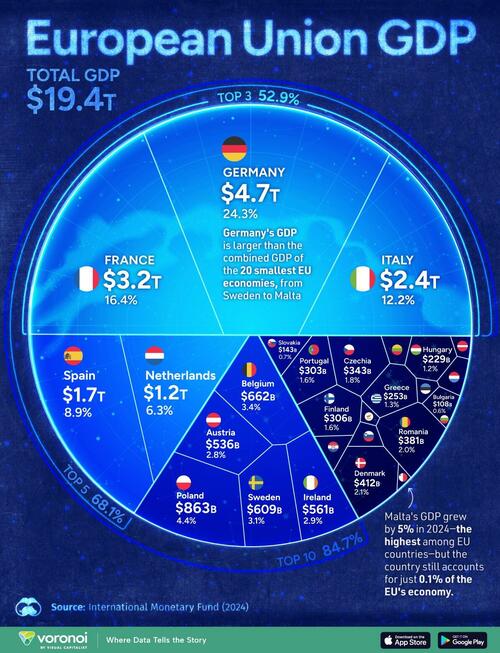Visualizing The European Union’s $19 Trillion Economy
The European Union, a political and economic bloc of 27 member countries, has faced uneven growth in recent years, with its largest economies experiencing stagnation or mild contractions.
Despite recent challenges, the EU continues to be a significant global economic force, underpinned by its strong industrial base, developed financial sector, and extensive trade relationships, though its overall influence is subject to increasing competition.
This graphic, via Visual Capitalist’s Kayla Zhu, visualizes the GDP the European Union’s 27 member countries in U.S dollars. Data is for 2024.
Data comes from the International Monetary Fund.
Europe’s Economic Giants Hold Their Ground
Below, we show each EU country’s GDP in 2024 and their share of EU’s total GDP.
| Rank | Country | 2024 GDP (USD) | Share of EU Economy |
|---|---|---|---|
| 1 | 🇩🇪 Germany | 4.7T | 24.3% |
| 2 | 🇫🇷 France | 3.2T | 16.4% |
| 3 | 🇮🇹 Italy | 2.4T | 12.2% |
| 4 | 🇪🇸 Spain | 1.7T | 8.9% |
| 5 | 🇳🇱 Netherlands | 1.2T | 6.3% |
| 6 | 🇵🇱 Poland | 863B | 4.4% |
| 7 | 🇧🇪 Belgium | 662B | 3.4% |
| 8 | 🇸🇪 Sweden | 609B | 3.1% |
| 9 | 🇮🇪 Ireland | 561B | 2.9% |
| 10 | 🇦🇹 Austria | 536B | 2.8% |
| 11 | 🇩🇰 Denmark | 412B | 2.1% |
| 12 | 🇷🇴 Romania | 381B | 2.0% |
| 13 | 🇨🇿 Czechia | 343B | 1.8% |
| 14 | 🇫🇮 Finland | 306B | 1.6% |
| 15 | 🇵🇹 Portugal | 303B | 1.6% |
| 16 | 🇬🇷 Greece | 253B | 1.3% |
| 17 | 🇭🇺 Hungary | 229B | 1.2% |
| 18 | 🇸🇰 Slovakia | 143B | 0.7% |
| 19 | 🇧🇬 Bulgaria | 108B | 0.6% |
| 20 | 🇱🇺 Luxembourg | 91B | 0.5% |
| 21 | 🇭🇷 Croatia | 90B | 0.5% |
| 22 | 🇱🇹 Lithuania | 83B | 0.4% |
| 23 | 🇸🇮 Slovenia | 73B | 0.4% |
| 24 | 🇱🇻 Latvia | 46B | 0.2% |
| 25 | 🇪🇪 Estonia | 43B | 0.2% |
| 26 | 🇨🇾 Cyprus | 35B | 0.2% |
| 27 | 🇲🇹 Malta | 24B | 0.1% |
Germany, France, and Italy have long been the EU’s largest economies, driven by industrial strength, financial hubs, and manufacturing power.
Together, they account around 53% of the EU’s $19.4 trillion GDP, with Germany alone surpassing the combined output of the 20 smallest EU economies.
However, these top three economies saw stagnating or negative growth last year.
Spain and the Netherlands round out the top five, bringing their collective share to 68%. Meanwhile, Malta posted the highest GDP growth at 5% in 2024 but remains the EU’s smallest economy at just 0.1% of the total.
The UK, which joined the EU in 1973 and officially left in 2020, recorded a GDP of $4.4 trillion in 2024—placing it second only to Germany if it were still in the EU.
To see more regional GDP breakdowns, check out this graphic that visualizes Asia’s economy by country.
Tyler Durden
Wed, 02/12/2025 – 02:45





Share This Article
Choose Your Platform: Facebook Twitter Linkedin